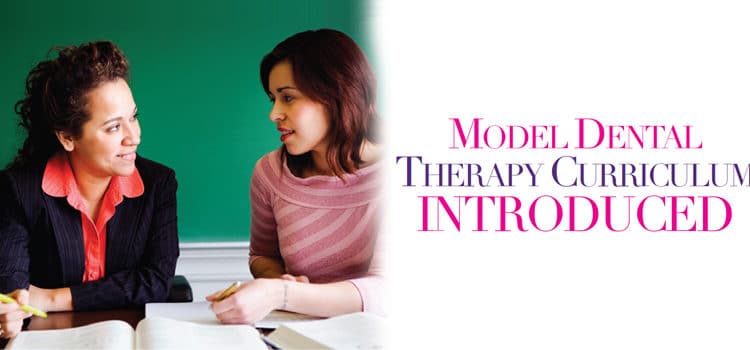 JACK HOLLINGSWORTH/DIGITALVISION/GETTYIMAGESPLUS
JACK HOLLINGSWORTH/DIGITALVISION/GETTYIMAGESPLUS
Model Dental Therapy Curriculum Introduced
As more states strengthen and modernize their oral health delivery systems via dental therapy, schools now have an important resource to develop high-quality training programs to educate this emerging workforce.
A model dental therapy curriculum is now available for community colleges and universities interested in launching programs to prepare this workforce. Written to meet dental therapy guidelines issued in 2015 by the Commission on Dental Accreditation (CODA), this sample curriculum can help educational institutions streamline what is often an arduous process of developing new training programs. The curriculum—released by Community Catalyst and developed with input from the American Association of Community Colleges, W.K. Kellogg Foundation, and The Pew Charitable Trusts—was designed to be flexible. Community colleges can offer it as an associate-degree program, or it can serve as the base for more advanced degrees offered by 4-year colleges and universities in concert with community colleges in instances when such collaborations are possible. The program can also be abridged for students entering as dental hygienists.
DENTAL THERAPISTS
Dental therapists are part of the oral health care team. In collaboration with a dentist, they provide preventive and restorative care, in addition to health education, in community settings to help improve oral health. Dental therapists practice in more than 50 countries. In 2004, they began expanding the reach of oral health care teams working on Indian Country in Alaska and in 2011, dental therapists began practicing in Minnesota statewide. Since 2014, Maine and Vermont have authorized dental therapy, Washington approved its use for Native American populations, Oregon has allowed two tribes to hire dental therapists, and an additional dozen states are considering legislation—all with the aim of expanding access to care for the underserved.
A workgroup composed of dentists, dental hygienists, community college officials, and other health experts participated in this curriculum project. The product is an adaptation of Alaska’s dental therapy curriculum, which consists of a 2-year full-time certificate program originally operated by a tribal health organization, to an associate degree format that can be offered by community colleges.
In early 2016, after a long collaboration with the University of Washington MEDEX program, the Alaska Native Tribal Health Consortium (ANTHC) shifted its dental therapy training program to Ilisagvik College, Alaska’s only regionally accredited Tribal College and a member of the American Association of Community Colleges. Ilisagvik modified the curriculum to meet the requirements of an Associate of Applied Science in Dental Health Therapy degree. The 69-credit, 1,500 clinical hour curriculum was approved by the Northwest Commission on Colleges and Universities—the regional accrediting board for Alaska’s academic institutions—and students began matriculating in August 2016.
The curriculum was developed to also meet new dental therapy accreditation standards released in 2015 by CODA—recognized by the United States Department of Education as the accreditor for all dental practitioner education programs. Because CODA has not yet begun to accredit dental therapy programs, this curriculum remains to be approved. Ilisagvik College is now preparing for the CODA approval process.
STRENGTHS OF CURRICULUM
Ilisagvik’s curriculum includes the content used to train dental therapists to successfully serve Alaska’s native population, many of whom are in remote communities that have never had routine access to a dentist. A 2010 evaluation conducted by the independent Research Triangle Institute found that the quality of care provided by dental health aide therapists is on par with that of dentists for the procedures they have in common.
Given the strong track record of the ANTHC program and the Ilisagvik curriculum’s alignment with CODA standards, the workgroup reviewed and moved to support it as a model for community colleges in states and tribal sovereignties. Community colleges may offer the model curriculum in total or in part. It is a starting point and can be customized to fit specific college formats and is abridged for students entering as dental hygienists. It can also serve as the core for degree programs offered in collaboration between community colleges and 4-year colleges and universities. And while Ilisagvik College will seek CODA accreditation for this curriculum, some states may require that dental therapy education programs meet other standards in addition to those prescribed by CODA.
CODA’s dental therapy guidelines call for at least 3 academic years of training, without prescribing a specific degree requirement, such as a Bachelor of Science. Dental hygienists and dental assistants are also given credit for the education they have already received. This opens the door for community colleges to play a central role in training dental therapists.
Curriculum developers are particularly interested in boosting the role of community colleges in providing this training, with nearly half of the campuses located in rural areas where the shortage of dentists is most acute. Community college administrators are driven to address the educational and workforce needs of their communities and to provide affordable training for some of the nation’s most underserved students. Community colleges have educated the majority of the nation’s dental hygienists; therefore, they stand out as a natural fit for training dental therapists.
As more states strengthen and modernize their oral health delivery systems by authorizing dental therapy, schools have gained an important resource to develop high-quality training programs to educate this emerging workforce. Progress on both fronts is certain to benefit millions of underserved Americans.
From Perspectives on the Midlevel Practitioner, a supplement to Dimensions of Dental Hygiene. October 2017;4(10):22-23.

